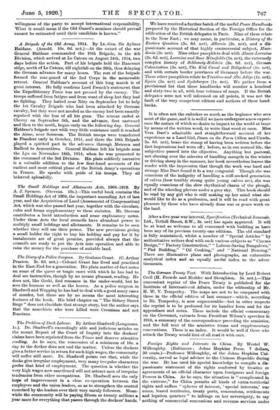A: Brigade of the Old Army, 1914. By Lt.-Gen. Sir
Aylmer Haldane. (Arnold. 10s. 6d. net.)—At the outset of the war General Haldane commanded the 10th Brigade, in the 4th Division, which arrived at Le Cateau on August 24th, 1914, two days before the action. Part of his brigade held the Hancourt ridge, north of Le Cateau, till nightfall on the 26th, thus delaying the German advance for many hours. The rest of the brigade formed the rear-guard' of the 2nd Corps in the memorable retreat. General Haldane's account of this long march is of great interest. He fully confirms Lord French's statement that the Expeditionary Force was not pressed by the enemy. The troops suffered from fatigue and from want of sleep but they had no fighting. They halted near Nery on September let to help the 1st Cavalry Brigade who had been attacked by German cavalry, but they were not needed as the enemy had been smartly repulsed with the loss of all his guns. The retreat ended at Chevry on September 5th, and the advance, first eastward and then to the north, began early on the following day. General Haldane's brigade met with very little resistance until it reached the Aisne, near Soissons. The British troops were transferred to Flanders early in. October, 1914, and there the 10th Brigade played a spirited part in the advance through Meteren and BaiNut to Armentieres. General Haldane left his brigade near the Lys on November 18th, 1914, when. he was promoted to the command of the 3rd Division. His plain soldierly narrative is a valuable addition to the few first-hand accounts of the' earliest and most critical phase of the British Army's operations in France. He speaks with pride of his troops. They all behaved splendidly.


































 Previous page
Previous page